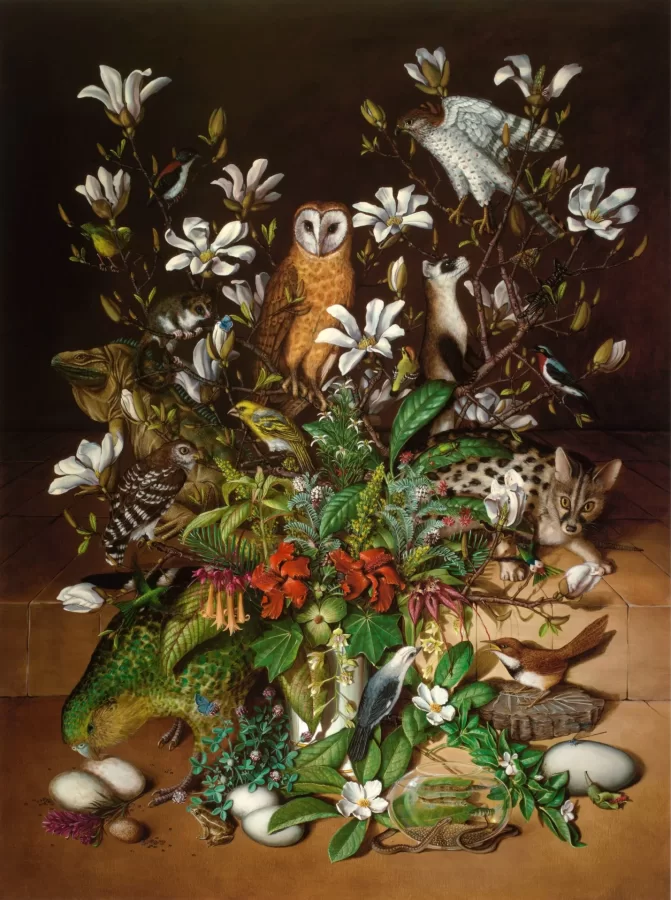Collection Highlight: Isabella Kirkland’s Back

When I first looked at Back by Isabella Kirkland, I was intrigued by the busyness in the painting. Contrasted with the black background, the work displays an explosion of plants and animals out of the void. The animals and plants are full of life; the colors are vivacious, but abruptly stop at the black background. A key to each animal with both its common and scientific name on the artist’s website showed her interest in depicting specific animals that viewers can identify. The animals themselves vary; an owl is surrounded by lemurs, a kakapo or taonga picks at a whooping crane egg, and snakes and a frog linger at the bottom, barely noticeable amidst all the other larger animals and white flowers. The species coexist in the same timeless space, as if they would share the same habitat in real life. Her other similar works also follow this chaotic interweaving of flora and fauna–animals and plants appearing out of (and disappearing into) a black background.
I was interested in why all the plants and animals were chosen, and it led me to more of Kirland’s work, where she has made several pieces about taxidermy and animal anatomy. In particular, she uses techniques from seventeenth-century Dutch masters, including their methods of identifying plants and animals, to discuss how human activity may lead to the extinction of much of the life she paints. The animals and plants in this painting were on the brink of extinction, but then were brought “back”–hence the title–underscoring the impact of human practices on numerous species.
Her paintings balance themes of time, nature, and human interference. She believes in the importance of using her practice to communicate threats about human destruction to nature, stating, “I choose to apply accuracy in a different service: my analog and intentionally durable works in oil reflect selected flora and fauna of earth that may well outlast the species depicted in them.” In painting each animal and plant as its own character in the story she is telling, sometimes interacting with their prey or predator, she reiterates nature’s liveliness, interdependence, and precariousness.
Although this piece is alluring, aesthetic, and detailed, I felt slightly unsettled while looking at it. The Madagascar Red Owl near the top of the piece stares at the viewer as if confronting us with the damage we are doing to its home. At the bottom of the piece, eggs from several species of birds suggest the possibility of new life teeming in the future. The fact that the eggs have not started to hatch, however, suggests this also hangs in the balance. On her website, Kirkland draws specific attention to the Owens Pupfish. It was listed as federally endangered in 1967 and almost went extinct in 1969 if not for a biologist and his colleagues. It is notably the only animal in a glass fishbowl, as if Kirkland has deemed it unsafe for the fish to exist without protection, even in a fictional world.
The animals in this work will continue to fascinate me in the diverse species they represent and the way they are physically placed in the painting. They immerse us humans in their world. However, the ominous black background also reminds us all that the world we live in is fragile and temporary, and if we don’t protect it, the natural world will fade into nothingness.
Sources:
https://theinterval.org/salon-talks/02016/mar/22/painting-endangered-world
https://www.isabellakirkland.com
https://www.isabellakirkland.com/species-keys/taxa/back
https://www.isabellakirkland.com/collections/taxa/paintings/back